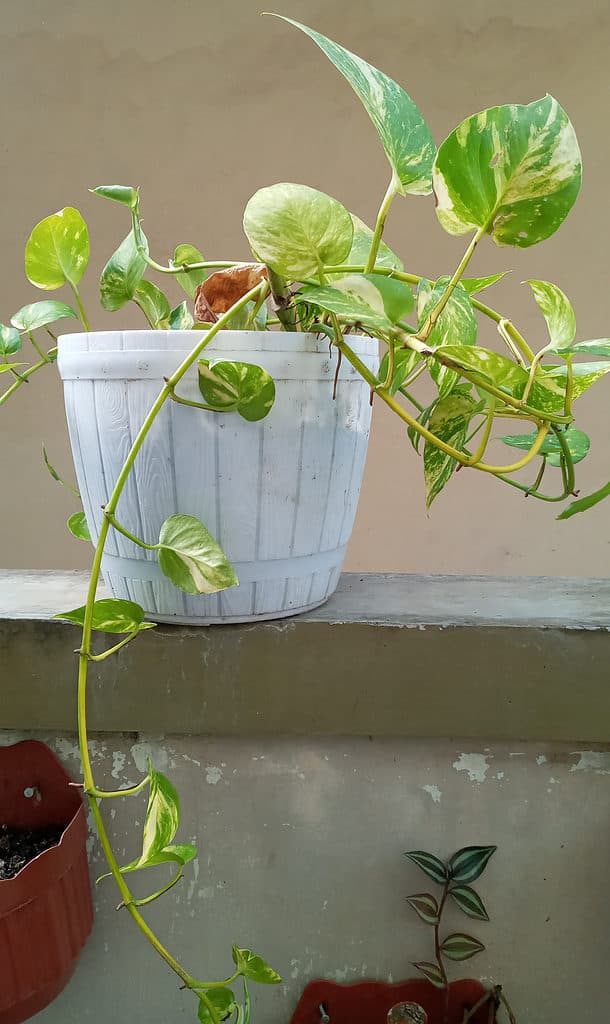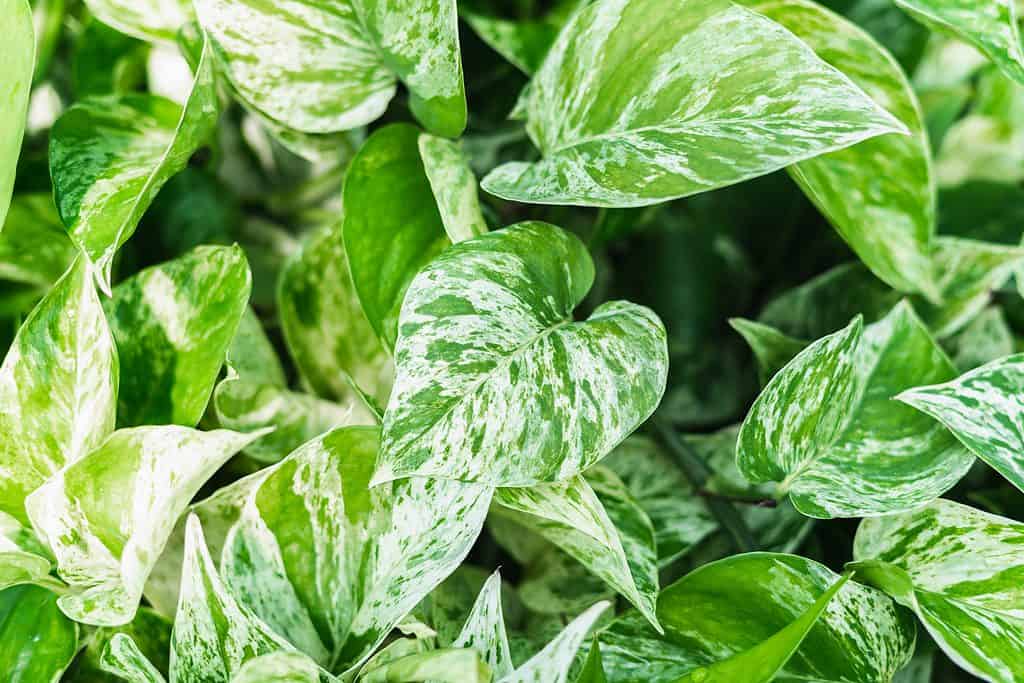A more recent variety of the beloved Epipremnum aureum species is the Jessenia pothos plant. Because of its hardiness and bright green marbling, it has increased in popularity in the last few years among plant collectors and houseplant enthusiasts.
Due to its toughness and tolerance of less-than-ideal environments and circumstances, the pothos plant, often known as devil’s Ivy or the money plant, is one of the most common indoor vines. The Jessenia pothos is simply a stunning marbled cultivar of this common tropical houseplant.
In this guide, we’ll go over planting, growing, and caring for Jessenia pothos. We’ll also look at some important facts regarding this special little plant.
What is the Jessenia Pothos?
The Jessenia pothos is a variety of Epipremnum aureum, collectively known as pothos. It is a member of the Araceae plant family. It is classified as Epipremnum aureum ‘Jessenia’. This particular cultivar is known for having a unique variegation that is a deeper, brighter lime color over the typical whitish or pale variegation found in other common varieties. This tropical houseplant is low maintenance, prefers bright and indirect light, and can thrive indoors for up to 10 years. This variety can also grow to be able 10 feet long, making it a smaller cultivar compared to other pothos cultivars. It can be planted outdoors in USDA hardiness zones 10 through 12.
This cultivar, which is a brightly colored relative of the golden pothos, was introduced by Costa Farms in 2014 and has since been immensely popular. The Jessenia pothos came from a stable line of the well-loved marble queen pothos cultivar. The wild Epipremnum aureum which thrives in tropical parts of Southeast Asia, the Pacific Islands, and Australia is the source of all of these domesticated varieties of pothos.
For plant gardeners of all ages and abilities, this plant is amazingly easy to grow as an indoor plant. It requires little maintenance and can do without watering quite often. Even with very little fertilizer, it can thrive and grow like a weed. The Jessenia pothos could be the ideal plant for you if you’ve been wanting to add a distinctive burst of color to your interior but don’t have a lot of spare time to take care of houseplants.

Jessenia pothos (pictured) boasts lime and chartreuse variegation.
©iStock.com/Bayu SRI TANJUNG
How to Care for Jessenia Pothos
The Jessenia pothos is well-recognized for being resilient and easy to cultivate, much like all other pothos plants. It grows slowly and needs a little bit more light than other non-variegated varieties, such as the golden pothos, in order to sustain its variegation.
The Jessenia pothos prefers to be watered once the top two or three inches of soil have dried up, much like other species of pothos do. These plants, however, are renowned for being comparatively drought tolerant and can endure the sporadic lack of hydration. When the plant isn’t actively growing in the fall and winter and goes semi-dormant, reduce watering frequency.
The Jessenia pothos, which is native to tropical areas with rainforests, thrives in warm and humid environments. You should keep this pothos in an environment with humidity levels of 50% to 70% and temperatures of 65 to 75 degrees F. Anything below 50 degrees F can be detrimental to this plant’s health.
Bright, indirect light is ideal for growing this variegated plant. It can, however, also handle mild or minimal light rather well. Unlike other types of pothos, the Jessenia pothos should not be grown in low light since it will lose its variegation. What’s the point of having this beautiful variety if it loses all of its neon stripes and speckles? One should also avoid direct sunlight as well since it will burn this plant’s foliage.
The Jessenia pothos needs a combination of soil that drains properly but yet holds some water. A mixture of potting soil, perlite, and some tree bark mix is preferable and will provide some good drainage and aeration. However, this plant can live for a while in pure potting soil. Throughout the active growing season, consistent fertilization promotes the Jessenia pothos’ slow growth. During the spring and summer, water these plants once a month while applying a balanced liquid fertilizer. Throughout the fall and winter, completely stop fertilizing. Overfertilization can quickly kill any pothos variety.
How to Propagate Jessenia Pothos
Cuttings are the best method for Jessenia pothos propagation. Cuttings are merely separated plant parts that are then rooted in water or a mossy mixture. By chopping off sections of your Jessenia pothos vine, you can produce a lot of baby pothos plants. You will get new pothos in no time if you support the young cuttings correctly as they root and leave adequate nodes. Nodes are the brownish nubs that link leaves to stems on pothos plants. The nodes are where the cutting’s new roots and leaves will emerge.
Start by using a pair of sharp and sterilized scissors that have been cleaned with diluted alcohol. Simply put, this will guarantee that you don’t spread any diseases to your current plant. On your Jessenia pothos, locate a long healthy vine and count back three or four leaves from the tip of the vine. Make sure there are still at least two or three nodes above the cut.
The cutting should be placed in a jar of water with the lowest nodes completely immersed once the bottom two leaves have been removed. This jar can be kept in the same environment as the mother plant: a warm spot with soft indirect light that is neither very bright nor too dark.
You’ll start to notice roots growing from the stem cutting in a few weeks. Before putting the cutting into soil, many plant collectors often wait as least a month to let the roots really grow out. Roots that are two to four inches long and starting to branch out should be present on the cutting. Prepare a container with potting soil, then gently insert the freshly rooted cutting with the roots facing down into the soil mixture.
Your young plants will require lots of air movement to their roots, so as you backfill, be cautious not to compact the mixture. Give the transplant a thorough watering, then care for it as any other mature pothos!
How to Identify Jessenia Pothos
Jessenia pothos looks like quite a few other pothos varieties, so distinguishing them is important if you’re looking to purchase this specific cultivar. Because this cultivar looks so similar to others, they are often mislabelled at nurseries and online shops. So, arm yourself with knowledge to ensure you are actually purchasing a true Jessenia.
The Jessenia pothos shares similarities with its parent plant, the marble queen pothos. The key distinction between the two is that the marble queen pothos often has a much lighter cream-colored variegation, whilst the Jessenia’s variegation has a lime green tinge. Some Jessenia leaves even have additional stripes, spots, and swirls of lime and forest green that resemble a smeared green painting.
Sometimes the Jessenia is also mistaken for the golden pothos, which is often considered the “base” variety of Epipremnum aureum. The Jessenia pothos keeps to lime and forest green colors, whilst the golden pothos is clearly golden and lime green. The Jessenia pothos often develops more slowly than golden pothos or jade pothos, just like many of the marbled or variegated varieties of this species. This is mostly due to the lower chlorophyll content and hence lower photosynthetic capability of the lighter-colored variegation on its leaves.
While it grows more slowly, the heart-shaped leaves and chartreuse speckles make the Jessenia pothos considerably more desirable to lovers of houseplants. The Jessenia pothos’ vibrant leaf color will be most visible in indirect, strong light. Drabber leaves with less distinctive variegation will arise from lower light.

The marble queen pothos (pictured) is more white or silver in appearance when compared to the Jessenia pothos.
©DJD_Media/Shutterstock.com
Common Jessenia Pothos Problems
As long as the proper circumstances are met, the Jessenia pothos is generally headache-free. There are several straightforward methods you can employ to deal with pests, root rot, or leaf problems if they arise.
Mealybugs and gnats are the major pests that harm indoor pothos plants. A straightforward neem oil remedy can get rid of all of these irritating pests. Simply dilute neem oil with water and use a moist cloth to wipe the neem straight onto the leaf surfaces. This will eliminate current bugs and stop the development of new ones.
The Jessenia pothos will be more prone to root rot if you overwater it or grow it in soil that is compacted. This can cause growth to stall as well as yellowing leaves. The pothos should be moved into a new container with better-draining soil to solve these issues.
Old leaves will occasionally turn yellow and eventually die, but if you see a lot of yellowing or brown leaves on your Jessenia, there could be a more serious problem at hand. A surplus of water can cause drooping and even discoloration. A leaf’s look might become browned or crispy from not getting enough water. Similar in appearance, leaf scorch caused by excessive light will have sunburned areas on the leaves and less brilliant colors. Low light levels can cause leaves to yellow or have a dull, pale tint. Better soil, careful attention to your watering techniques, and transferring the plant to a more suitable sunlit area can all help with all of these issues.
Do Jessenia Pothos Grow Flowers?
Mature Jessenia pothos can absolutely produce flowers. Pothos flowers are generally cream or white-colored and are shaped like a spade. However, pothos that are kept as houseplants almost always stay in their juvenile form and will very rarely ever flower or grow quite as big as wild pothos. But since the Jessenia pothos’ foliage is so stunning, the lack of flowers really isn’t a big deal.
Are Jessenia Pothos Toxic to Pets?
Dogs, cats, and people can all be poisoned by all species of pothos. It is best to keep them high up, out of reach of children or animals, in hanging baskets or on shelves. The primary negative effects of consuming or chewing on this plant are nausea, vomiting, diarrhea, swelling lips or throat, burning or itchy mouth, and contact dermatitis. Luckily, the Jessenia pothos enjoys winding around any kind of trellis or structure and is easy to keep away from animals and young children.
The Jessenia pothos is an excellent variety of pothos to add to any plant collection. It is particularly ideal for those who want to enjoy variegated pothos but prefer a lime-green, vibrant color pattern over the typical white and silver variegation of more common varieties. The Jessenia pothos is a special cultivar that can brighten up any indoor space!
Up Next:
- Monstera Albo: Discover This Enchanting Variegated Monstera
- Astrological Houseplants: Find Your Perfect Zodiac Plant Match
- 6 House Plants That Purify The Air
The photo featured at the top of this post is © iStock.com/Bayu SRI TANJUNG
Thank you for reading! Have some feedback for us? Contact the AZ Animals editorial team.






